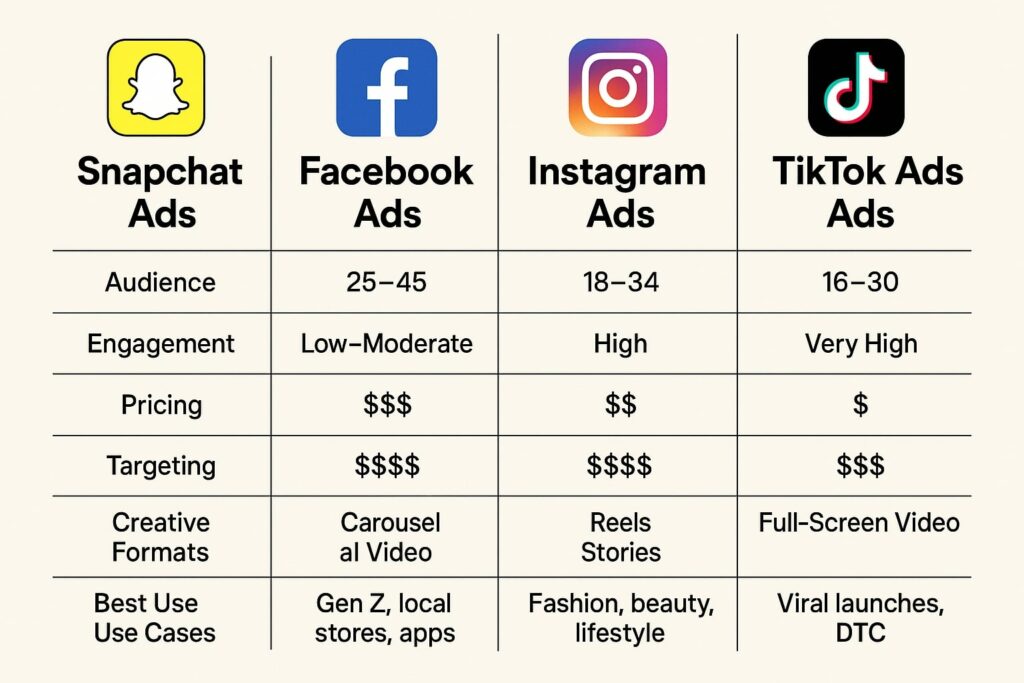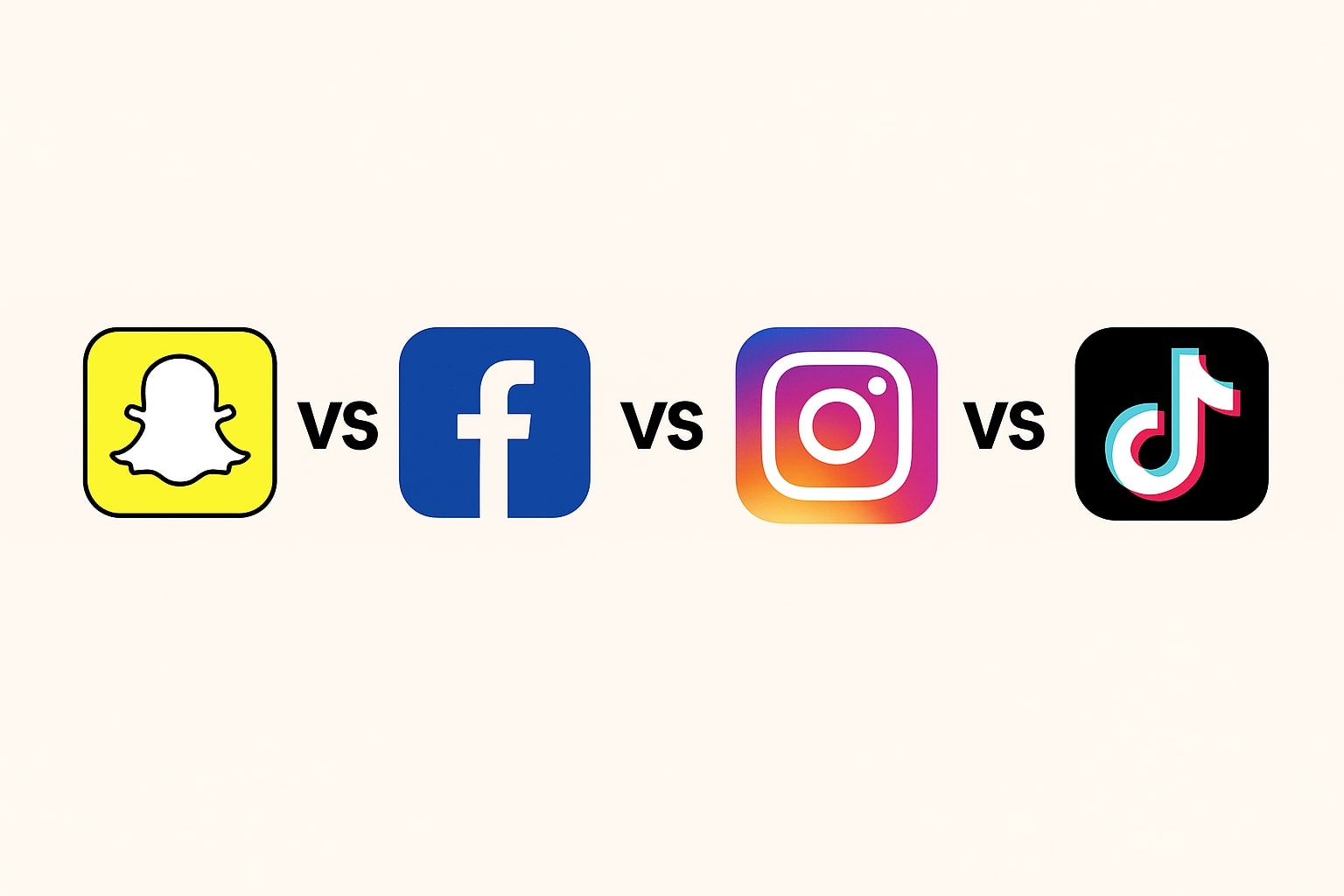This article aims to provide a detailed comparison of advertising platforms on Snapchat, Facebook, Instagram, and TikTok. The analysis will incorporate both performance metrics and strategic insights, focusing on how each platform serves different audience segments, creative examples, and practical advice. The goal is to help marketers, small business owners, and digital experts make informed decisions regarding their advertising strategies.
Table of Contents
- Introduction
- Snapchat Advertising
- Facebook Advertising
- Instagram Advertising
- TikTok Advertising
- Comparative Analysis of Advertising Features
- Strategic Recommendations and Best Practices
- Conclusion
Introduction
In today’s digital landscape, advertising on social media platforms has evolved into a central strategy for brands and marketers alike. This article provides a comprehensive comparative analysis of advertising on four leading platforms—Snapchat, Facebook, Instagram, and TikTok. As businesses seek to optimize their advertising spend and maximize engagement, understanding the unique attributes and performance metrics of each platform becomes essential. This analysis examines audience demographics, available ad formats, targeting capabilities, engagement trends, and practical case studies, offering strategic recommendations to navigate the dynamic ecosystem of social media advertising.
The significance of this study lies in its ability to guide marketers in selecting the most suitable platform based on their specific campaign goals, creative direction, and target audience. By exploring the strengths and limitations of Snapchat, Facebook, Instagram, and TikTok, this article equips small business owners, digital experts, and advertising professionals with actionable insights to drive impactful advertising campaigns.
1. Snapchat Advertising
Snapchat has steadily emerged as a platform uniquely positioned to engage a younger audience, making it a vital channel for campaigns targeting Millennials and Gen Z. This section delves into the key facets of Snapchat advertising, discussing its distinctive features, audience characteristics, ad formats, and best practices.
1.1 Audience Demographics and Behavior
Snapchat is synonymous with spontaneity and ephemeral content. Its core demographic comprises younger users, predominantly in their teens and early twenties. This audience is highly engaged with content that is interactive, immersive, and authentic. Snapchat’s audience tends to favor quick, visually appealing content that offers a behind-the-scenes glimpse into brand identity. Marketers can leverage this behavioral trend by focusing on short video content and interactive filters.
1.2 Advertising Formats on Snapchat
Snapchat offers a diverse array of ad formats designed to capture the fleeting attention spans of its youthful user base. Some of the most prominent ad types include:
- Snap Ads: Full-screen vertical video ads that appear in between user-generated stories. These ads can incorporate interactive elements such as swipe-up links to websites or product pages.
- Sponsored Lenses and Filters: These augmented reality (AR) experiences allow brands to create engaging and memorable interactions with users by overlaying creative digital elements on top of live camera feeds.
- Collection Ads: These provide a way to showcase multiple products in a seamless, interactive shopping experience within a single ad unit.
Each of these formats leverages the platform’s emphasis on visual storytelling and interactivity, reinforcing brand presence in a manner that resonates with a mobile-first audience.
1.3 Engagement and Performance Metrics
The ephemeral nature of Snapchat creates a distinct set of performance metrics compared to other platforms. Key performance indicators for Snapchat advertising typically include:
- View-through rates: How many users watch a Snap ad in its entirety.
- Engagement metrics: Interactions through swipes, taps on AR lenses or filters, and direct responses.
- Completion rates: The percentage of users who complete the ad experience.
- Cost-per-swipe (CPS): A measure that highlights the cost efficiency of campaigns when driving user interactions with ad content.
While Snapchat may not always provide the granular analytical detail available on more mature platforms, its innovative ad formats and direct appeal to a younger demographic make it a powerful tool for brand awareness and short-term engagement campaigns.
1.4 Best Practices for Snapchat Advertising
To capitalize on the strengths of Snapchat, marketers should consider the following strategies:
- Embrace Creativity: Develop ads that are visually captivating and fleeting in nature, ensuring content aligns with the platform’s spontaneous style.
- Leverage AR Capabilities: Use sponsored lenses and filters to create memorable brand interactions.
- Test and Optimize: Run A/B tests on ad creatives to identify what resonates best with the younger demographic.
- Prioritize Mobile Experience: Ensure that landing pages and linked content are optimized for mobile viewing, maintaining the seamless user experience that Snapchat users expect.
2. Facebook Advertising
As one of the most mature and established social media platforms, Facebook offers a robust suite of advertising tools powered by sophisticated targeting and measurement capabilities. This section provides an in-depth look at Facebook advertising, highlighting its extensive reach, advanced segmentation features, and diverse creative ad formats.
2.1 Audience Demographics and Behavior
Facebook remains a platform with one of the most diverse and expansive user bases available. With over a billion active users spanning a broad age spectrum—from teenagers to senior citizens—Facebook offers unmatched opportunities for demographic targeting. Its community-driven environment fosters both personal connections and group interests, creating a fertile ground for marketers to engage with a varied audience.
2.2 Advertising Formats on Facebook
Facebook’s advertising ecosystem includes a multitude of ad formats designed to support diverse campaign objectives. Some notable formats include:
- Image and Video Ads: These are straightforward yet powerful tools, enabling brands to tell their story through high-quality visuals and compelling narratives.
- Carousel Ads: Allowing multiple images or videos within a single ad unit, these are ideal for showcasing a range of products or benefits.
- Collection Ads: Providing a seamless transition from discovery to purchase, these ads integrate product catalogs with engaging visuals.
- Messenger Ads: Enabling direct communication and personalized interactions with customers, Messenger ads bridge the gap between casual browsing and customer engagement.
Facebook’s dynamic Ad Manager further empowers advertisers by allowing advanced segmentation based on interests, behaviors, locations, and more, making it possible to tailor campaigns with unmatched precision.
2.3 Engagement and Performance Metrics
Facebook’s advertising platform offers detailed insights into campaign performance through a range of metrics:
- Click-through rates (CTR) and conversion rates: These metrics provide insight into how effectively ads drive traffic and generate measurable actions.
- Engagement metrics: Including likes, shares, and comments, these help gauge the resonance of the ad with the target audience.
- Return on Ad Spend (ROAS): A critical metric for assessing the financial efficiency of advertising investments.
- Audience Insights: Detailed analytics that allow marketers to further understand demographic engagement and behavior patterns.
The comprehensive measurement tools available on Facebook ensure that advertisers can continuously refine and improve campaign performance.
2.4 Best Practices for Facebook Advertising
To achieve superior results on Facebook, marketers are encouraged to adopt the following best practices:
- Targeting Precision: Make full use of Facebook’s extensive demographic, behavioral, and interest-based targeting options.
- Compelling Creatives: Invest in high-quality visuals and engaging copy that resonate with the diverse Facebook audience.
- Leverage Retargeting: Utilize retargeting strategies to re-engage users who have previously interacted with your brand.
- Monitor Performance: Regularly analyze ad performance metrics and adjust strategies accordingly to maximize ROAS.
3. Instagram Advertising
As a visually driven platform, Instagram has carved out its niche for brands aiming to deliver aesthetically pleasing and inspirational content. In this section, we explore Instagram’s capabilities as an advertising medium, its audience traits, ad formats, and tips for fostering high engagement levels.
3.1 Audience Demographics and Behavior
Instagram is renowned for its focus on visual storytelling, attracting a predominantly younger demographic that values creativity and lifestyle expression. The platform’s user base, while diverse, skews toward Millennials and younger users who are frequently inspired by high-quality imagery, fashion, lifestyle, food, and travel content. This environment fosters a culture of aspiration and discovery, making Instagram ideal for brands that can merge visual appeal with brand messaging.
3.2 Advertising Formats on Instagram
Instagram offers several ad formats that allow brands to craft engaging and interactive experiences:
- Photo and Video Ads: These enable brands to showcase products or tell a story in a visually arresting manner.
- Carousel Ads: Allowing multiple images or videos in one ad, these provide a narrative sequence that can effectively highlight different features or aspects of a product.
- Stories Ads: These full-screen vertical ads appear between user-generated stories. Given the ephemeral nature of Stories content, these ads have a high engagement potential.
- Reels Ads: With the growing popularity of short-form videos, Reels ads cater to audiences that appreciate quick, engaging, and creative content.
The emphasis on aesthetics and quality on Instagram means that advertisers must focus on producing high-caliber visual content that aligns with the platform’s artistic ethos.
3.3 Engagement and Performance Metrics
Instagram advertising is measured by a variety of performance metrics that help advertisers understand audience interaction:
- Engagement Rates: Likes, comments, shares, and saves are key indicators of how well content resonates with the audience.
- Story Views and Reach: For Stories and Reels ads, view count and duration serve as valuable metrics.
- CTR and Conversion Rates: These metrics help gauge the effectiveness of ads in driving actionable outcomes.
- Cost per Engagement (CPE): This metric offers insights into the efficiency of ad spend relative to audience interactions.
3.4 Best Practices for Instagram Advertising
Optimal performance on Instagram can be achieved through the following strategies:
- Visual Excellence: Prioritize high-quality visuals and aesthetically consistent content that aligns with your brand identity.
- Storytelling Approach: Develop narratives that are both engaging and visually compelling to hold the audience’s attention.
- Leverage Influencers: Collaborate with influencers who resonate with your target audience to amplify reach and authenticity.
- Engage Actively: Use interactive features such as polls, quizzes, and swipe-up links in Stories to foster a two-way engagement with your audience.
4. TikTok Advertising
TikTok has redefined the social media advertising landscape with its high-energy, fast-paced video content. As a platform that thrives on viral trends and creative expression, TikTok offers a unique set of opportunities and challenges for brands. This section discusses TikTok’s audience, ad formats, engagement metrics, and strategic approaches for maximizing advertising impact.
4.1 Audience Demographics and Behavior
TikTok’s user base is predominantly composed of younger generations, with Gen Z at the forefront. The platform’s unique algorithm and content format promote rapid discovery and virality, enabling individual pieces of content to achieve exponential reach within a short time span. Users on TikTok are drawn to creative, authentic, and humorous content, which encourages brands to adopt a playful yet strategic approach to advertising.
4.2 Advertising Formats on TikTok
TikTok offers several innovative and interactive ad formats, including:
- In-Feed Ads: These are short, native ads that appear as users scroll through their “For You” feed. They blend seamlessly with user-generated content, making them less intrusive.
- Branded Hashtag Challenges: These campaigns encourage user participation and content creation around a specific branded theme, driving viral engagement and widespread brand awareness.
- Branded Effects: Similar to Instagram’s AR filters, these allow users to interact with branded visual effects, adding a playful element to ad campaigns.
- TopView Ads: These ads appear immediately when users open the app, offering an immersive full-screen experience that is ideal for grabbing attention right at the start.
4.3 Engagement and Performance Metrics
TikTok advertising metrics focus on both reach and the virality potential of content:
- Video Views and Engagements: The number of views, likes, shares, and comments provide a direct measure of user interaction.
- User-Generated Content (UGC): Success is partly measured by the quantity and quality of UGC generated through hashtag challenges.
- Cost per Mille (CPM) and Cost per Engagement (CPE): These metrics allow advertisers to evaluate the efficiency of ad spend.
- Virality Index: A less formal metric that considers the speed and scale of content sharing across the platform.
4.4 Best Practices for TikTok Advertising
Successful advertising on TikTok relies on creative ingenuity and strategic alignment with platform trends. Recommended best practices include:
- Embrace Authenticity: Create content that feels spontaneous and relatable. Brands that show a genuine personality tend to attract deeper engagement.
- Participate in Trends: Monitor emerging trends on TikTok and incorporate them into campaigns to enhance visibility.
- Interactive Campaigns: Encourage user participation through challenges and contests, ensuring that the brand message is embedded seamlessly within the creative concept.
- Optimize for Mobile: Ensure that all ad creatives are optimized for vertical video format, catering to TikTok’s mobile-first user experience.
5. Comparative Analysis of Advertising Features
To facilitate an informed decision for marketers, it is essential to compare these platforms side by side. The following table offers a qualitative comparison of key advertising features among Snapchat, Facebook, Instagram, and TikTok.
Figure 1: Comparative Overview of Key Advertising Features
| Feature | Snapchat | TikTok | ||
|---|---|---|---|---|
| Primary Audience Age | Teens to Early 20s | All Ages (Broad spectrum) | Young Adults (18-34) | Teens to Early 20s |
| Ad Formats | Snap Ads, Sponsored Lenses, Filters, Collection Ads | Image & Video, Carousel, Collection, Messenger | Photo, Video, Carousel, Stories, Reels | In-Feed, Hashtag Challenges, Branded Effects, TopView |
| Targeting Capabilities | Demographic & Behavioral | Extensive demographic, interests, behaviors | Interest-based and behavioral, with influencer integration | Behavioral trends with viral potential |
| Engagement Style | Interactive, AR-driven | Social sharing, detailed interactions | Visual, lifestyle-oriented | Creative, viral, fast-paced |
| Best for | Brand awareness among Gen Z | Broad reach and conversion campaigns | High-impact visual storytelling | Rapid engagement and viral marketing |
Explanation:
This table highlights that while Snapchat and TikTok both cater primarily to a younger audience through interactive and visually engaging ad formats, Facebook accommodates a broader demographic with precise targeting options. Instagram, with its focus on high-quality visual content, occupies an intermediary position with strong emphasis on lifestyle and visual appeal.
6. Strategic Recommendations and Best Practices
Each platform requires a tailored approach to maximize advertising efficiency. Below, we summarize strategic recommendations aligned with campaign objectives and creative strategies.
6.1 Holistic Campaign Strategy
- Define Clear Objectives
Before launching a campaign, it is critical that marketers establish clear, measurable objectives. Whether the goal is brand awareness, lead generation, or direct conversion, the choice of platform should align with these objectives. - Segmentation and Personalization
Utilize the rich targeting features available—Facebook’s detailed segmentation, Instagram’s behavioral cues, and TikTok’s trend analysis—to deliver personalized ad experiences. Personalization boosts engagement and fosters stronger connections with potential customers.
6.2 Creative Development and Messaging
- Leverage Platform-Specific Strengths
- For Snapchat, prioritize ephemeral content and interactivity. Use creative visuals that encourage users to explore sponsored lenses and filters.
- For Facebook, integrate storytelling with robust targeting. Marry high-quality visuals with persuasive narratives that drive conversion.
- For Instagram, invest in creative assets that reflect aesthetic consistency and lifestyle appeal. Ensure that each ad tells a story that aligns with your brand image.
- For TikTok, experiment with informal and entertaining content. Emphasize authenticity and embrace trends to capture fleeting attention through engaging, short-form videos.
- Consistent Branding Across Platforms
While creative adaptations are necessary, maintain a consistent brand voice and visual style across all platforms. This consistency reinforces brand identity and aids in building long-term customer trust.
6.3 Budget Allocation and Measurement
- Budget Flexibility Based on Data Insights
Allocate budgets dynamically based on observed performance metrics. Platforms such as Facebook provide detailed analytics that help refine spending; meanwhile, experimental budgets on TikTok can tap into viral trends. - Continuous Measurement and Optimization Techniques
Monitor key performance indicators (KPIs) such as CTR, engagement rates, conversion percentages, and ROAS. Leverage A/B testing for ad creatives and messaging. Continuous measurement helps in identifying what resonates best with your audience, allowing for real-time optimization.
6.4 Integrating Influencer Collaborations
- Capitalizing on Influencers
Especially on Instagram and TikTok, collaborations with influencers can amplify reach and inject authenticity into campaigns. Influencer partnerships enable brands to tap into highly engaged communities while benefiting from the credibility of personalities that resonate with target demographics. - Case Scenarios and Practical Examples
- A startup targeting Gen Z might partner with emerging TikTok creators in a hashtag challenge to drive user-generated content.
- A well-established lifestyle brand might collaborate with influencers on Instagram to demonstrate product usage in aspirational settings.
- Brands that aim to reach a broader demographic may blend Facebook retargeting with influencer-driven Instagram campaigns for a holistic approach.
6.5 Addressing Platform-Specific Challenges
- Ad Fatigue and Content Renewal
On platforms with rapid content turnover, such as TikTok and Snapchat, advertisers must be prepared to refresh creative assets frequently to combat ad fatigue. - Data Privacy and Consumer Trust
With increased regulation around data privacy, platforms such as Facebook and Instagram need to adhere strictly to privacy standards. Marketers should be transparent about data usage and leverage this trust to foster longer-term customer relationships.
7. Strategic Recommendations: Detailed Action Plan
Below is a detailed table that summarizes best practices and strategic action points for each platform.
Table 2: Strategic Action Points by Platform
| Strategy Aspect | Snapchat | TikTok | ||
|---|---|---|---|---|
| Audience Engagement | Emphasize AR-driven creative experiences | Leverage interactive content and community | Focus on high-quality visuals and storytelling | Utilize short, trend-based videos |
| Targeting & Segmentation | Basic demographic and behavioral targeting | Extensive detailed targeting parameters | Interest-based targeting combined with influencer synergism | Leverage trend analytics and viral factors |
| Creative Formats | Full-screen Snap Ads, filters, lenses | Carousel, Collection, Messenger ads | Stories, Reels ads, Carousel, image/video ads | In-Feed Ads, Hashtag Challenges, TopView Ads |
| Budget Flexibility | Agile budgets for short-term campaigns | Data-driven budget allocation and retargeting | Moderate budgets focused on brand consistency | Experimental budgets for trend campaigns |
| Performance Metrics | View-through, swipe rates, completion rates | CTR, conversion, ROAS, audience insights | Engagement rates, story/reel views, CPE | Video views, engagement rates, virality index |
| Key Considerations | Creative spontaneity, mobile optimizations | Comprehensive analytics, privacy, and retargeting | Aesthetic consistency, influencer collaborations | Authentic content, rapid creative iterations |
Explanation:
This table serves as a quick-reference guide that aligns marketing strategies with the unique advantages and challenges of each platform. It provides a clear framework for making informed decisions based on campaign objectives and the specific strengths of each advertising channel.
8. Conclusion
The dynamic landscape of social media advertising demands a nuanced understanding of the varying features and benefits of each platform. This comparative analysis highlights several key insights:
- Audience Alignment: Snapchat and TikTok excel in reaching younger demographics with engaging, quick-hit visual content, while Facebook provides unparalleled targeting to a broad spectrum of ages and interests. Instagram, with its focus on visual storytelling, bridges the gap by appealing primarily to aesthetically driven and lifestyle-conscious users.
- Creative Versatility: Each platform offers unique ad formats—from Snapchat’s AR-enhanced interactions and TikTok’s viral hashtag challenges to Facebook’s extensive carousel options and Instagram’s immersive Stories. Marketers must align creative strategies with platform attributes.
- Rigorous Measurement: Effective advertising hinges on rigorous performance measurement. Advanced targeting and analytics on Facebook and Instagram versus engagement-driven metrics on Snapchat and TikTok require different optimization strategies.
- Strategic Implementation: Flexibility in budget allocation, continuous A/B testing, and influencer collaborations are critical steps in driving successful campaigns. A holistic understanding of platform-specific best practices ensures that marketing budgets are invested where they yield the highest engagement and conversion.
Main Findings:
- Audience Demographics: Snapchat and TikTok predominantly attract Gen Z, Facebook provides a broad demographic, and Instagram primarily reaches young adults.
- Ad Format Diversity: Innovative, interactive ad formats distinguish these platforms—each requires a creative approach that aligns with its user behavior.
- Targeting and Engagement: Facebook’s advanced targeting contrasts with TikTok’s viral potential and Snapchat’s immersive AR experiences, influencing campaign strategy.
- Strategic Best Practices: Embrace creativity and continuous optimization while integrating influencer partnerships and data-driven insights to craft campaigns that capture user attention and drive conversions.
In conclusion, the choice between Snapchat, Facebook, Instagram, and TikTok should be based on a clear understanding of campaign goals, target audience demographics, and the creative potential of each platform. By leveraging the strengths of these platforms in a tailored strategy, marketers can maximize impact, drive deeper engagement, and ultimately optimize advertising investments.
Call to Action:
Marketers are encouraged to conduct pilot campaigns on multiple platforms, monitor their performance closely, and iterate based on real-world feedback. Whether you are a small business owner eager to experiment with new ad formats or a seasoned digital strategist aiming for enhanced engagement, integrating insights from this comparative analysis will help you drive more effective and resonant digital marketing campaigns.
🧑🤝🧑 1. Audience Demographics
| Platform | Primary Age Group | Gender Split | Key Markets |
|---|---|---|---|
| Snapchat | 13–24 | ~55% female | US, UK, India, Middle East |
| 25–45 | Balanced | Global, esp. older users | |
| 18–34 | ~52% female | Urban, lifestyle-focused | |
| TikTok | 16–30 | ~60% female | Gen Z, urban youth |
📈 2. Engagement and Reach
| Platform | Engagement Level | Virality Potential |
|---|---|---|
| Snapchat | Moderate (private sharing) | Low–Moderate |
| Low–Moderate (declining organic) | Low | |
| High (Reels, Stories) | Medium–High | |
| TikTok | Very High (For You Page) | Very High |
💰 3. Ad Cost & ROI (CPM/CPC Range)
| Platform | CPM (Cost per 1000 Impressions) | CPC (Cost per Click) | ROI Potential |
|---|---|---|---|
| Snapchat | $2–$8 | $0.30–$1.00 | Medium (for Gen Z/young users) |
| $5–$12 | $0.50–$2.00 | High (broad targeting) | |
| $4–$10 | $0.50–$1.50 | High (visual brands) | |
| TikTok | $1–$4 | $0.10–$0.50 | Very High (viral creatives) |
🎯 4. Targeting Capabilities
| Platform | Data Depth | Retargeting | Lookalike Audiences |
|---|---|---|---|
| Snapchat | Moderate | Yes | Limited |
| Advanced | Yes | Yes | |
| Advanced | Yes | Yes | |
| TikTok | Good | Yes | Yes |
🎨 5. Ad Formats & Creative Style
| Platform | Best Formats | Style Needed |
|---|---|---|
| Snapchat | Stories, Filters, Lenses | Raw, playful, mobile-first |
| Carousel, Video, Lead Forms | Informative, clean, flexible | |
| Reels, Stories, Carousel | High visual appeal, polished | |
| TikTok | Full-screen video, Branded Effects | Fun, fast-paced, authentic |
💼 6. Best Use Cases
| Platform | Ideal For |
|---|---|
| Snapchat | Gen Z engagement, local stores, app installs |
| Lead generation, retargeting, ecommerce, older demos | |
| Fashion, beauty, lifestyle, influencer content | |
| TikTok | Viral product launches, user-generated content, DTC |
🧠 Summary Recommendation:

-
Use Snapchat if targeting Gen Z, promoting mobile apps, or want native-looking AR filters.
-
Use Facebook for conversion-heavy campaigns, B2B, or when leveraging detailed audience segmentation.
-
Use Instagram for aesthetic-driven brands, especially in fashion, beauty, or travel.
-
Use TikTok if you’re chasing organic-style virality, especially for trendy products or impulse buys.


 Practical Guide for Enhancing Sales with AI Agents
Practical Guide for Enhancing Sales with AI Agents





